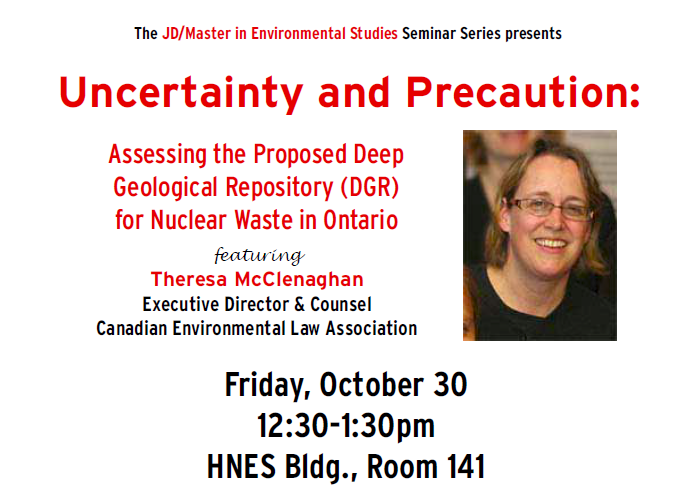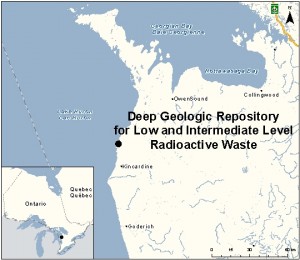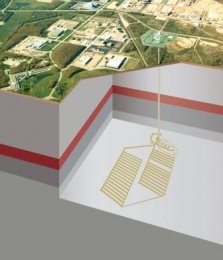
On Friday, October 30, 2015, the Osgoode Environmental Justice & Sustainability clinical program, the JD/Master in Environmental Studies Joint Program and the Sustainable Energy Initiative at the Faculty of Environmental Studies are pleased to present a public lecture by the Canadian Environmental Law Association's Executive Director, Theresa McCleneghan, on the perils of Ontario Power Generation's proposal to construct a deep geological repository (DGR) to store at least 200,000 cubic metres of low and medium-level nuclear waste at Bruce Power's nuclear generation plant near Kincardine, Ontario, on the shore of Lake Huron.
The waste, which will come from the Bruce, Pickering and Darlington nuclear power plants, would be buried in a limestone formation 680m below the surface, around one kilometre inland from the lake.

Map of the proposed site (Canadian Environmental Assessment Agency)
OPG calls its proposed DGR "one of the safest places to store low and intermediate‑level nuclear waste." Others are not so sure.
OPG has pushed its proposal forward in the face of large and growing public opposition.
The proposed site is on the traditional territory of the Chippewas of Nawash Unceded First Nation and the Chippewas of Saugeen First Nation, who are concerned that the repository could adversely affect their aboriginal and treaty rights.
Opponents worry that radioactivity from the waste will contaminate air, soil, or water over the very long lifetime of the repository. Many pointed out that OPG neither considered nor evaluated any other actual sites. More than 150 municipalities around the Great Lakes passed resolutions condemning the proposal. Chicago's resolution, adopted in January, 2015, warned that "A leak of radioactive waste would almost certainly have a cataclysmic effect on the delicate ecological balance of the world's largest group of interconnected freshwater bodies of water."
CELA has raised concerns about the proposal since 2006 and participated actively in a 40-month Joint Panel Review established by the Canadian Nuclear Safety Commission and the federal Minister of the Environment.
CELA and other concerned groups commissioned and presented expert evidence about numerous technical uncertainties.
Despite these concerns, in May, 2015, the Joint Review Panel found that the DGR is the preferred solution for the long-term management of low- and intermediate-level nuclear waste. The report (PDF) concluded that the DGR will be safe under both normal conditions and unlikely "what-if" scenarios, is preferable to other sites, will not cause significant adverse environmental effects if properly implemented, and will not affect Lake Huron. The report emphasized that the safe operation of the DGR will depend upon the complete, timely and continuing implementation of numerous mitigation, monitoring and management measures into the long-term future. 
The federal government immediately announced that it would consult aboriginal groups and other stakeholders about the proposed mitigation and follow-up measures before making a final decision on the DGR proposal. A final decision is due in early December.
CELA and other environmental groups criticized the Panel report as deeply flawed. They urged the Ontario government, as OPG's sole shareholder, to direct that OPG withdraw its proposal and to initiate a needs assessment with respect to the storage and management of radioactive wastes at OPG's nuclear plants.
Whatever happens with the OPG proposal, the process followed in this case will be a precedent for future proposals for the disposal of high-grade nuclear waste, including spent fuel.
Theresa McClenaghan represented CELA in the joint review process and will present her reflections on the OPG proposal, the joint review and the future of nuclear waste management in Ontario.
The public lecture takes place at 12:30-1:30 pm on Friday, October 30, in Room 141 of the Health, Nursing and Environmental Studies Building at York University. It will be followed by a private, invitation-only chat and lunch with Theresa for students in the EJS Clinical Program and the JD/MES Joint Program.

